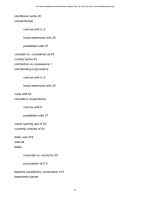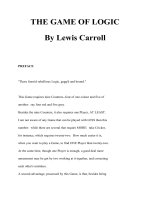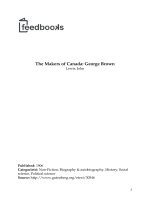The Elements of Investing by Burton_5 pptx
Bạn đang xem bản rút gọn của tài liệu. Xem và tải ngay bản đầy đủ của tài liệu tại đây (258.75 KB, 18 trang )
85
Avoid Blunders
In addition to the timing penalty, there is also a selec-
tion penalty. When money poured into equity mutual
funds in late 1999 and early 2000, most of it went to the
riskier funds — those invested in high tech and Internet
stocks. The staid “ value ” funds, which held stocks sell-
ing at low multiples of earnings and with high dividend
yields, experienced large withdrawals. During the bear
market that followed, these same value funds held up
very well while the “ growth ” funds suffered large price
declines. That ’ s why the gap between the actual returns
of investors and the overall market returns is even larger
than the two percentage point gap cited earlier.
Fortunately, there ’ s hope. Mr. Market can only hurt us
if we let him. That ’ s why we all need to learn that getting
tricked or duped by Mr. Market is actually our fault. As
Mom said, we can only get teased or insulted or hurt by
bad people if we let them. As an investor, you have one
powerful way to keep from getting distressed by devilish
Mr. Market: Ignore him. Just buy and hold one of the
broad - based index funds that we list on pages 117–119.
MORE MISTAKES
Psychologists have identifi ed a tendency in people to
think they have control over events even when they
c04.indd 85c04.indd 85 10/31/09 1:37:01 PM10/31/09 1:37:01 PM
86
The Elements of Investing
have none. For investors, such an illusion can lead them
to overvalue a losing stock in their portfolio. It also
can lead people to imagine there are trends when none
exist or believe they can spot a pattern in a stock price
chart and thus predict the future. Charting is akin to
astrology. The changes in stock prices are very close to a
“ random walk ” : There is no dependable way to predict
the future movements of a stock ’ s price from its past
wanderings.
The same holds true for supposed “ seasonal ” patterns,
even if they appear to have worked for decades in the
past. Once everyone knows there is a Santa Claus rally
in the stock market between Christmas and New Year ’ s
Day, the “ pattern ” will evaporate. This is because inves-
tors will buy one day before Christmas and sell one day
before the end of the year to profi t from the supposed
regularity. But then investors will have to jump the gun
even earlier, buying two days before Christmas and
selling two days before the end of the year. Soon all the
buying will be done well before Christmas and the selling
will take place right around Christmas. Any apparent
stock market “ pattern ” that can be discovered will not
last — as long as there are people around who will try to
exploit it.
c04.indd 86c04.indd 86 10/31/09 1:37:02 PM10/31/09 1:37:02 PM
87
Avoid Blunders
Psychologists also remind us that investors are far
more distressed by losses than they are delighted by
gains. This leads people to discard their winners if they
need cash and hold onto their losers because they don ’ t
want to recognize or admit that they made a mistake.
Remember: Selling winners means paying capital gains
taxes while selling losers can produce tax deductions.
So if you need to sell, sell your losers. At least that way
you get a tax deduction rather than an increase in your
tax liability.
MINIMIZE COSTS
There is one investment truism that, if followed, can
dependably increase your investment returns: Minimize
your investment costs. We have spent two lifetimes
thinking about which mutual fund managers will have
the best performance year in and year out. Here ’ s what
we now know: It was and is hopeless.
There is one investment truism that,
if followed, can dependably increase
your investment returns: Minimize
your investment costs.
c04.indd 87c04.indd 87 10/31/09 1:37:02 PM10/31/09 1:37:02 PM
88
The Elements of Investing
Here ’ s why: Past performance is not a good predictor
of future returns. What does predict investment perfor-
mance are the fees charged by the investment manager.
The higher the fees you pay for investment advice, the
lower your investment return. As our friend Jack Bogle
likes to say: In the investment business, “ You get what
you don ’ t pay for. ”
Let ’ s demonstrate this proposition with the simple
table shown on page 89. We look at all equity mutual
funds over a 15 - year period and measure the rate of return
produced for their investors as well as all the costs charged
and the implicit costs of portfolio turnover — the cost of
buying and selling portfolio holdings. We then divide
the funds into quartiles and show the average returns and
average costs for each quartile. The lowest - cost quartile
funds produce the best returns.
If you want to own a mutual fund with top quartile
performance, buy a fund with low costs. Of course, the
quintessential low - cost funds are the index funds we
recommend throughout this book. If we measure after -
tax returns, recognizing that high turnover funds tend
to be tax ineffi cient, our conclusion holds with even
greater force.
c04.indd 88c04.indd 88 10/31/09 1:37:02 PM10/31/09 1:37:02 PM
89
Avoid Blunders
Costs and Net Returns: All General Equity Funds
12/31/1994 –
12/31/2008
A nnual T otal
R eturn
L atest
T otal
E xpense
R atio
A nnual
P ortfolio
T urnover
Low - cost
quartile
7.24% 0.71% 25.5%
Quartile two 6.51% 1.09% 54.5%
Quartile three 5.87% 1.33% 80.8%
High - cost
quartile
4.65% 1.80% 146.5%
Sources: Lipper and Bogle Financial Research Center.
While we are on the subject of minimizing costs, we
need to warn you to beware of stockbrokers. Brokers
have one priority: to make a good income for them-
selves. That ’ s why they do what they do the way they
do it. The stockbroker ’ s real job is not to make money
for you but to make money from you. Of course, brokers
tend to be nice, friendly, and personally enjoyable for
c04.indd 89c04.indd 89 10/31/09 1:37:02 PM10/31/09 1:37:02 PM
90
The Elements of Investing
one major reason: Being friendly enables them to get
more business. So don ’ t get confused. Your broker is
your broker — period.
The typical broker “ talks to ” about 75 customers
who collectively invest about $ 40 million. (Think
for a moment about how many friends you have and
how much time it takes you to develop each of those
friendships.) Depending on the deal he has with his
firm, your broker gets about 40 percent of the com-
missions you pay. So if he wants a $ 100,000 income,
he needs to gross $ 250,000 in commissions charged
to customers. Now do the math. If he needs to make
$ 200,000, he ’ ll need to gross $ 500,000. That means
he needs to take that money from you and each of
his other customers. Your money goes from your
pocket to his pocket. That ’ s why being “ friends ” with
a stockbroker can be so expensive. Like Mr. Market, a
broker has one priority: getting you to take action,
any action.
We urge you not to engage in “ gin rummy ” behavior.
Don ’ t jump from stock to stock or from mutual fund
to fund as if you were selecting and discarding cards
in a gin rummy game and thereby running up your
commission costs (and probably adding to your tax bill
c04.indd 90c04.indd 90 10/31/09 1:37:02 PM10/31/09 1:37:02 PM
91
Avoid Blunders
as well). In fact, we don ’ t think individual investors
should try to buy individual stocks or try to pick par-
ticular actively-managed mutual funds. Buy and hold
a low - cost broad - based index fund and you are likely
to enjoy well-above-average returns because of the low
costs you pay.
c04.indd 91c04.indd 91 10/31/09 1:37:02 PM10/31/09 1:37:02 PM
c04.indd 92c04.indd 92 10/31/09 1:37:02 PM10/31/09 1:37:02 PM
93
V
KEEP IT SIMPLE
I n his attempts to unlock the complex secrets of the
universe, Albert Einstein, the greatest scientist of
the twentieth century, had one overriding maxim:
“ Everything should be made as simple as possible — but
no simpler. ” We agree.
We know that the fi nancial press is full of stories about
the complexity of modern fi nance and that the investment
world often appears frighteningly complex. But despite
all the convoluted gimmicks some charlatans would like
c05.indd 93c05.indd 93 11/3/09 10:16:20 AM11/3/09 10:16:20 AM
94
The Elements of Investing
to sell you (because they are so profi table for the sellers),
you can prosper by embracing simplicity.
That ’ s why this chapter presents some very simple, easy
to understand and easy to follow rules to help you achieve
fi nancial security. While some individuals have uniquely
complex fi nancial circumstances, we believe the rules we
offer will work well for almost all investors. And the port-
folio we will present “ gets it right ” for at least 90 percent of
individual investors. We leave out — on purpose — all sorts
of complicated details that really are just minor adjust-
ments for the unusual circumstances that might affect par-
ticular individuals. *
In this section, we fi rst review the simple rules for suc-
cessful long - term investing. We then present, for you and
the loved one we hope you ’ ll discuss it with, the KISS
(Keep It Simple, Sweetheart ) portfolio. We think our
rules and portfolio recommendations contain the very
best advice that all investors require.
*
If
your fi nancial or tax situation is especially complex, then seek
the advice of a tax attorney or fi nancial adviser. You will be better
off with a “fee only” adviser. Advisers who earn commissions from
selling you specialized investments are more likely to recommend
high-expense fi nancial products from which they can earn substantial
commissions.
c05.indd 94c05.indd 94 11/3/09 10:16:20 AM11/3/09 10:16:20 AM
95
Keep It Simple
The KISS portfolio “ gets it right ” for at
least 90 percent of individual investors.
REVIEW OF BASIC RULES
Here are the basic rules in abbreviated form. We have
discussed most of them in earlier chapters.
1. Save early and regularly.
The most important step you can take to
building a comfortable nest egg and providing
for a worry - free retirement is to start saving early
and to keep saving regularly. There is no simple
road to riches for you and your family. The
secret to getting wealthy is that there is no secret.
The only way to get rich — unless you inherit or
marry a fortune or hit the lottery — is to get rich
slowly. Start early and contribute as much as
possible to your savings for as long as possible.
2. Use the help of your employer and Uncle Sam to
supercharge your savings.
We are amazed and distressed at how many
people do not take full advantage of their
employer ’ s 401(k) or 403(b) retirement security
c05.indd 95c05.indd 95 11/3/09 10:16:20 AM11/3/09 10:16:20 AM
96
The Elements of Investing
plan. Sadly, many people do not even join
the plan, even when their employer would
match every dollar the employee saves. And
Uncle Sam contributes a lot, too, because your
contributions are not taxed until many years
later, when you withdraw money needed to
enjoy your retirement.
3. Set aside a cash reserve.
As the bumper sticker tells us, stuff happens. We
need cash reserves for those “ cost surprises ” that
we learn to expect as part of life. Such reserves
should be invested in high - quality, short -
term instruments because safety of principal
and assured liquidity are your paramount
concerns. The size of the cash reserve is up to
you, but most fi nancial planners suggest that
in retirement, when no longer earning cash
income, you set aside at least six months of
living expenses. While you should not take on a
lot of risk by stretching for higher returns, you
should minimize costs as is appropriate with
all fi nancial instruments. The one investment
lesson we are absolutely sure of is that the
higher the expenses you pay the provider of
c05.indd 96c05.indd 96 11/3/09 10:16:20 AM11/3/09 10:16:20 AM
97
Keep It Simple
any investment service, the lower will be the
return to you.
The cash reserve could be invested in
government - guaranteed bank deposits or in safe
money - market funds. Shop for the highest rate
available. Internet banks often offer the best
rates. You may use savings accounts or bank
certifi cates of deposit (CDs), but make sure
that any savings deposit or CD is put in a
bank that is insured by the Federal Deposit
Insurance Corporation (FDIC).
While the money - market funds listed
later are not insured, they often have higher
rates and they give you the advantage of free
checking (for bills of $ 250 or more). These
money - market funds typically buy very
large CDs from banks or they purchase the
short - term obligations of prime corporate
borrowers. If you want to be super safe, you
can buy the money funds listed on page 99
that invest only in obligations guaranteed
by the U.S. government. (These are called
“ government ” or “ Treasury ” money - market
funds.)
c05.indd 97c05.indd 97 11/3/09 10:16:21 AM11/3/09 10:16:21 AM
98
The Elements of Investing
The lists in the table on the following page
also include tax - exempt money - market funds.
These funds invest in obligations of state and
local governments, and the interest paid by
these funds is exempt from federal taxation.
You might also check whether state tax - exempt
money - market funds exist for your state of
residence. These funds can avoid state income
taxes as well as federal taxes.
4. Make sure you are covered by insurance.
If you are the breadwinner in your family and
your spouse and children are dependent on
you for support, you need life insurance and
long - term disability insurance. And you need
medical insurance. But when you buy insurance,
remember the KISS principle: Buy simple, low -
cost term life insurance, not complex “ whole
life ” insurance, which combines a high - cost
investment program with the life insurance
you need.
The main cost driver of disability insurance
is the coverage for lost income when you can ’ t
work for a few months. You may decide to self -
insure against this moderate risk to reduce your
c05.indd 98c05.indd 98 11/3/09 10:16:21 AM11/3/09 10:16:21 AM
99
Keep It Simple
Selected Low-Cost Money-Market Funds
Fund Name Ticker Symbol
Expense
Ratio
One-Year Rate
of Return
a
Five-Year Rate of
Return
a
Vanguard Prime Money Market
www.vanguard.com; 800–662–7447
VMMXX 0.23% 1.65% 3.39%
Vanguard Admiral Treasury Money Market
Fund www.vanguard.com; 800–662–7447
VUSXX 0.15% 0.99% 3.09%
Vanguard Tax-Exempt Money Market
www.vanguard.com; 800–662–7447
VMSXX 0.17% 1.39% 2.52%
Fidelity Cash Reserves
www.fi delity.com; 800–343–3548
FDRXX 0.39% 1.72% 3.35%
Fidelity Government Money Market Fund
www.fi delity.com; 800–343–3548
SPAXX 0.45% 1.19% 3.14%
Fidelity Tax-Free Money Market Fund
www.fi delity.com; 800–343–3548
FMOXX 0.48% 0.79% 2.14%
a
Through 4/30/2009.
c05.indd 99c05.indd 99 11/3/09 10:16:21 AM11/3/09 10:16:21 AM
100
The Elements of Investing
costs substantially. The coverage you really want
is against the calamity of being unable to work
for years and years. Consider buying coverage
only against a major loss.
As with all fi nancial products you buy, shop
around. The overarching principle is that the
more you pay the provider of the fi nancial
service, the less there will be for you.
5. Diversifi cation reduces anxiety.
Diversifi cation reduces the risk of any invest-
ment program. You should hold not just a
few common stocks, but rather a broadly
diversifi ed portfolio. You should hold not
just U.S. stocks, but also the stocks of foreign
countries, including stocks in the fast - growing
emerging markets such as China, Brazil, and
India. You should hold bonds as well as stocks.
While stock markets all over the world tend
to go down together during times of fi nancial
crisis, broad diversifi cation usually reduces
both short - term and long - term risk.
6. Avoid all credit card debt — period.
There are few absolute rules in investing except
the avoidance of credit card debt. There is
c05.indd 100c05.indd 100 11/3/09 10:16:21 AM11/3/09 10:16:21 AM
101
Keep It Simple
no way you can get ahead of the game if you
are paying 18, 20, or 22 percent on your
outstanding credit card balance. If you do
have a credit card balance, the most profi table
investment you can make is to pay off your
credit card debt, so concentrate your efforts on
paying it off.
7. Ignore the short - term sound and fury of Mr.
Market.
The biggest mistakes investors make are letting
emotions dominate and being infl uenced by the
crowd. Investors cause themselves substantial
heartache and inferior returns by making buy
and sell decisions based on the provocations of
Mr. Market and the all - too - human tendency to
follow the herd, especially during the inevitable
periods of excessive optimism and pessimism.
When everyone around you is losing his or her
head, just stand there and do nothing. Keep
your eyes and your mind focused on the long
term.
8. Use low - cost index funds.
Nobody knows more than the total of all
knowledge of all those active and often expert
c05.indd 101c05.indd 101 11/3/09 10:16:21 AM11/3/09 10:16:21 AM
102
The Elements of Investing
investors who together determine the market
prices of stocks. It is true that the market
sometimes makes mistakes — often egregious
ones such as the overvaluation of high - tech and
Internet stocks at the turn of the century. But
many of the pundits who predicted the Internet
crash had been calling the market “ substantially
overvalued ” in 1992.
Market timers are wrong at least as often as
they are right, and when they are wrong, the
cost of being wrong is often quite substantial.
Yes, the market can and does make mistakes,
but don ’ t even try to outsmart it. Over the
past 50 years, our securities markets have been
transformed from markets dominated almost
entirely by individual investors to markets
dominated by full - time professional institu-
tional investors. Today, only the most remark-
ably gifted and diligent individual investors
should even begin to consider buying individ-
ual stocks in an attempt to beat the market.
We have 100 years of collective experience,
keep up with the professional literature, have
taught investing in leading graduate schools,
c05.indd 102c05.indd 102 11/3/09 10:16:21 AM11/3/09 10:16:21 AM









